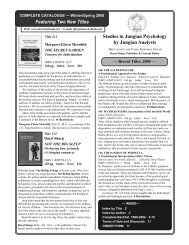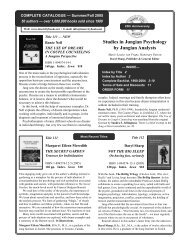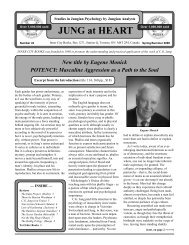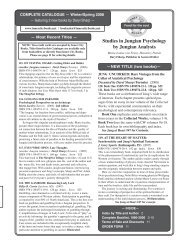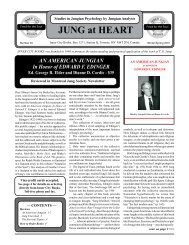Personality types: Jung's model of typology - Inner City Books
Personality types: Jung's model of typology - Inner City Books
Personality types: Jung's model of typology - Inner City Books
- No tags were found...
Create successful ePaper yourself
Turn your PDF publications into a flip-book with our unique Google optimized e-Paper software.
102 The Clinical Significance <strong>of</strong> Extraversion and Introversionadults we still find unconscious areas in need <strong>of</strong> development.This situation is conducive to conflicts that may provokecriticism and thus lead to the dissolution <strong>of</strong> a participationmystique.By conflict we understand that two persons in a given relationshipfind that they are not in complete harmony. The individualwho experiences this disturbance <strong>of</strong> harmony is thesubject and the partner to the conflict, with whom he feels indisharmony, is his object.We can observe how this disturbance manifests itself in theindividual: an affect is created, involving an animus-animaproblem. There is also a disturbance <strong>of</strong> adjustment to the nowobjectivated environment, which creates further effects, constellatingthe problem <strong>of</strong> the shadow.A classic example can be found in young children: they discoverthat the parents are not always as perfect as they hadexpected. The affect created is anger with the parents: the ensuingchurlishness leads to a problem <strong>of</strong> adjustment. The childis now exposed to doubts such as: "Who am I?", or "Who aremy parents?" And further, "What is this I?", "What is 'father','mother'?" In this way subject and object are born. This situationsoon constellates the parental arche<strong>types</strong>, hence the <strong>of</strong>tenconsiderable energy <strong>of</strong> the affect.The same problem arises for everyone when a participationmystique is dissolved. Although the problem is a general one,the way it is worked through varies according to whether theprimary interest is directed towards the subject or object. Theindividual way in which the problem is solved indicates thebasic attitude.The introvert is primarily concerned with the subject, andso he becomes aware <strong>of</strong> the disturbing factors in the subject.At this point the affect arises. He has a tendency to dampdown this affect, and devotes himself to this task with alacrityby seeking a new and reassuring orientation. His difficulty in



